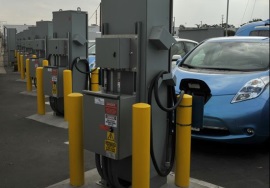
by Brianna Crandall — December 22, 2014—U.S. Air Force officials unveiled the Department of Defense’s first non-tactical vehicle fleet composed entirely of plug-in electric vehicles in November at Los Angeles Air Force Base, California. The rollout of the 42-vehicle fleet marks a milestone in the DOD’s demonstration of emerging technology, and the vehicles will serve as a resource to the electrical grid when they are not being driven, leading the way for organizations around the country.
The PEV fleet includes both electric and hybrid vehicles ranging from sedans to trucks and a 12-passenger van. The vehicles have the capability to direct power both to and from the electrical grid when they are not being driven, known as vehicle-to-grid technology. Unique charging stations have been installed on Los Angeles AFB to support the vehicles’ V2G capability.
The V2G technology enables the vehicles to provide more than 700 kilowatts of power to the grid, sufficient power for more than 140 American homes. The vehicles also enhance the power grid’s reliability and security by balancing demand against supply without having to use reserves or standby generators.
California energy providers and regulators worked closely with the Air Force on safety and performance testing as well as technical and regulatory aspects of launching the fleet, demonstrating the value of a shared investment and commitment to the nation as a whole.
The Air Force plans to expand the V2G demonstration to Joint Base Andrews, Maryland, and Joint Base McGuire-Dix-Lakehurst, New Jersey. The Air Force’s actions are expected to stimulate demand from both automotive suppliers and the electric industry in the states where the agency has ordered V2G-capable trucks and cars and placed them on bases, and to help move the technology from demonstration to early commercial-scale products.
In addition to the PEV fleet in L.A., the Air Force is also investigating the benefits of other alternative fuel vehicles. More than 9,000 ethanol flex fuel vehicles are in the service’s inventory worldwide, along with 50 biodiesel fuel stations on its installations. The service will also continue to look for additional capabilities, such as utilizing used batteries as a form of on-base energy storage.





